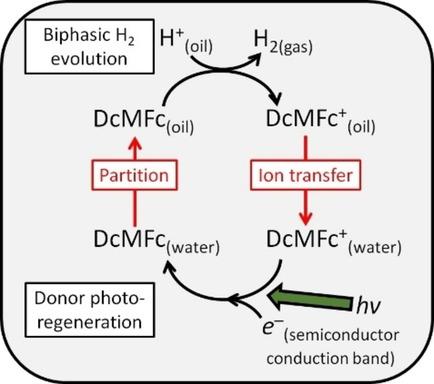当前位置:
X-MOL 学术
›
ChemPhysChem
›
论文详情
Our official English website, www.x-mol.net, welcomes your
feedback! (Note: you will need to create a separate account there.)
Photo‐recycling the Sacrificial Electron Donor: Towards Sustainable Hydrogen Evolution in a Biphasic System
ChemPhysChem ( IF 2.3 ) Pub Date : 2020-11-09 , DOI: 10.1002/cphc.202000844 Peiyu Ge 1 , Mohamad Hojeij 1 , Micheál D. Scanlon 2, 3 , Hubert H. Girault 1
ChemPhysChem ( IF 2.3 ) Pub Date : 2020-11-09 , DOI: 10.1002/cphc.202000844 Peiyu Ge 1 , Mohamad Hojeij 1 , Micheál D. Scanlon 2, 3 , Hubert H. Girault 1
Affiliation

|
H2 may be evolved biphasically using a polarised liquid|liquid interface, acting as a “proton pump”, in combination with organic soluble metallocenes as electron donors. Sustainable H2 production requires methodologies to recycle the oxidised donor. Herein, the photo‐recycling of decamethylferrocenium cations (DcMFc+) using aqueous core‐shell semiconductor CdSe@CdS nanoparticles is presented. Negative polarisation of the liquid|liquid interface is required to extract DcMFc+ to the aqueous phase. This facilitates the efficient capture of electrons by DcMFc+ on the surface of the photo‐excited CdSe@CdS nanoparticles, with hydrophobic DcMFc subsequently partitioning back to the organic phase and resetting the system. TiO2 (P25) and CdSe semiconductor nanoparticles failed to recycle DcMFc+ due to their lower conduction band energy levels. During photo‐recycling, CdS (on CdSe) may be self‐oxidised and photo‐corrode, instead of water acting as the hole scavenger.
中文翻译:

牺牲电子给体的光回收:在双相系统中实现可持续的氢释放
H 2可以与作为电子给体的有机可溶性茂金属组合,使用起“质子泵”作用的极化液界面双相析出。可持续的H 2生产需要循环利用氧化供体的方法。本文介绍了使用含水核壳半导体CdSe @ CdS纳米粒子对十甲基二茂铁鎓阳离子(DcMFc +)的光循环。为了将DcMFc +提取到水相中,需要液界面的负极性。这有助于DcMFc +高效捕获电子在光激发的CdSe @ CdS纳米颗粒的表面上,疏水性DcMFc随后分配回有机相并重置系统。TiO 2(P25)和CdSe半导体纳米颗粒由于其较低的导带能级而无法回收DcMFc +。在光循环过程中,CdS(在CdSe上)可能会被自氧化并被光腐蚀,而不是充当空穴清除剂的水。
更新日期:2020-12-17
中文翻译:

牺牲电子给体的光回收:在双相系统中实现可持续的氢释放
H 2可以与作为电子给体的有机可溶性茂金属组合,使用起“质子泵”作用的极化液界面双相析出。可持续的H 2生产需要循环利用氧化供体的方法。本文介绍了使用含水核壳半导体CdSe @ CdS纳米粒子对十甲基二茂铁鎓阳离子(DcMFc +)的光循环。为了将DcMFc +提取到水相中,需要液界面的负极性。这有助于DcMFc +高效捕获电子在光激发的CdSe @ CdS纳米颗粒的表面上,疏水性DcMFc随后分配回有机相并重置系统。TiO 2(P25)和CdSe半导体纳米颗粒由于其较低的导带能级而无法回收DcMFc +。在光循环过程中,CdS(在CdSe上)可能会被自氧化并被光腐蚀,而不是充当空穴清除剂的水。











































 京公网安备 11010802027423号
京公网安备 11010802027423号